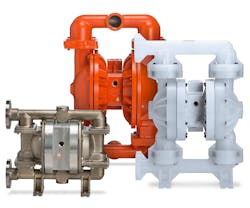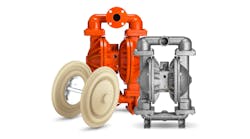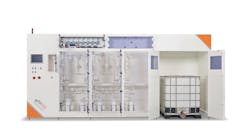There is no aspect of human existence that can function properly or reliably without energy, the preponderance of which is produced from refined crude oil, natural gas and coal. Therefore, it is imperative that companies that rely on energy to power their industrial manufacturing operations create and implement systems that are as energy efficient as possible, especially as energy costs continue to rise.
To aid these companies in both creating sustainable manufacturing regimes and battling increasing energy costs, a number of utilities — especially those that supply energy through the electrical power grid — have created rebate programs in which those industrial companies that are able to demonstrate that their methods of operation require less energy and are environmentally sustainable can be eligible to receive monetary refunds in their energy bills.
Knowing this, many industries are commendably attempting to develop new manufacturing and production methods — known as “sustainable manufacturing” — that are more environmentally and socially friendly. The caveat, however, is that while these methods can have long-term benefits for the future, they can also have higher upfront implementation costs.
The challenge
For our purposes, since air-operated double-diaphragm (AODD) pumps are powered by air, and air compressors are ultimately powered by electricity, let’s focus on that form of energy and how prices for a kilowatt/hour (kWh) of electricity have been influenced in recent years. In 2017, the average national price for a kWh was $0.07. In March 2022, that price had more than doubled to an average of 14.47 cents per kWh, which was up from 13.33 cents per kWh a year earlier.
The lucky residents in three states (Montana, Oregon and North Dakota) actually saw a decline in electricity prices from 2021 to 2022, but their averages (10.03 to 11.01 cents per kWh) were still higher than 2017’s national average. On the other hand, the state of Maine had seen its average kWh price jump more than 40% to 23.03 cents per kWh in 2022, making it one of eight states — with Alaska, California, Connecticut, Hawaii, Massachusetts, New Hampshire and Rhode Island being the unfortunate others — to have a kWh average higher than 20 cents.
While we may be talking about pennies, these higher costs can quickly add up for industrial operators that are the backbone of the global manufacturing chain. The Hydraulic Institute revealed the importance of electricity in industrial manufacturing in a study that showed industrial pumping systems can account for nearly 20% of the world’s electricity demand and that energy consumption can be up to 90% of the total cost of owning and operating a pump.
At the same time, it has been estimated that 30% to 50% of the energy that is consumed by pumps can be saved through the implementation of equipment or control-system upgrades. This makes pump systems an easy target for developing operational improvements that can lower energy consumption that will help optimize operating costs and create a more environmentally friendly mode of operation.
Which brings us back to the aforementioned “sustainable manufacturing.” According to the World Commission on Environment and Development, sustainable manufacturing is designed to “meet the needs of the present without compromising the capability of future generations to meet theirs.” This can be accomplished by manufacturing products via economical means and utilizing components that reduce waste and negative environmental impacts.
The claim that this altruistic mindset is being adopted by many of the world’s largest companies is backed by KPMG’s 2020 Survey of Sustainability Reporting that showed that 80% of the world’s leading companies are now reporting on their sustainability efforts and are incorporating sustainability programs into their day-to-day operational goals.
There are six elements that must be optimized to create a reliable, sustainable-manufacturing process and pumps that are capable of operating efficiently and sustainably can contribute to at least four of them: manufacturing cost, power consumption, operational safety and environmental friendliness. So, to overcome the challenges of energy acquisition and consumption while still being able to live up to the tenets of the growing sustainable-manufacturing movement, operators of industrial manufacturing facilities must find ways to improve their pumping systems and processes.
The solution
AODD pumps have proven over the decades to be one of the top choices for utilitarian pumping applications. They are reciprocating, positive-displacement pumps that are driven by electricity-generated compressed air.
AODD pumps are the best solution for many industrial liquid-handling applications because of their simple design, which simply features two diaphragms that are connected by a common shaft, two inlet valve balls and two outlet valve balls. The diaphragms are driven by the compressed air, which is delivered to the pump via electricity. As noted, electricity prices have increased in recent years.
The engineers at Wilden invented the Pro-Flo SHIFT Air Distribution System (ADS) to help reduce the overall amount of compressed air needed to operate the pump while simultaneously optimizing the air that is used. The inefficiency in the operation of traditional ADSs is the time delay that AODD pumps experience when pressurized air is switched from one air chamber to the other, which results in overfilling the air chamber.
To combat overfilling, the design and operation of the Pro-Flo SHIFT ADS restricts the air flow into the air chamber near the end of each pump stroke so that only enough air is introduced to keep the pumping process functioning. The key here is the incorporation of a specialized air control spool that automatically meters the air to prevent overfilling with no reduction of product yield. The result is reduced air consumption while still maintaining maximum operational efficiency and flow rates.
For example, one manufacturing facility replaced its existing AODD pump with a Wilden Pro-Flo SHIFT model, which was run 7.5 hours a day and five days a week. The result: savings of up to $1,000 in annual energy costs to operate just that one pump. Additionally, since the manufacturer was able to show documented proof that the Wilden pump was reducing energy consumption to its energy supplier, the utility gave the manufacturer a rebate that helped it pay for the new pump.
Conclusion
With energy costs continuing to increase and companies encouraged to make their manufacturing operations more sustainable, finding the right pumping technology has never been more important. AODD pump technology is proven to ease energy consumption and contribute to more sustainable manufacturing processes. They deserve a spot as a first-choice pumping solution for many of the world’s most significant manufacturing operations.
About the Author:
Tom Zuckett is the AODD Business Development Manager, Americas for PSG and Wilden and can be reached at [email protected].


